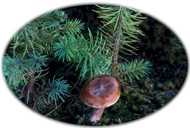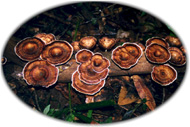|
|
Fungal diversity & lignocellulose degradation
Project Leader:
Dr Ian Anderson
Project start date:
December, 2000
Objective:
To investigate the molecular ecology and diversity of fungi in acid organic upland soils in relation to their role in litter decomposition and nutrient cycling.
Background/Introduction:
Microbial decomposition of organic material is the main process whereby nitrogen and other nutrients are released from organic matter into the soil nutrient pool. Most of these nutrients are essential to the growth and health of plants and other organisms, however, many soil types are nutrient limited. In many instances, vast amounts of nutrients are tightly bound in organic matter and are thus unavailable to plants and other organisms for direct uptake and utilisation. Indeed, this is the case for the majority of upland Scottish soils, which are characterised as being
acidic organic soils with high levels of organic matter (>33%). While both bacteria and fungi have a role to play in the release of nutrients from organic matter, fungi are the principal degrading organisms in  this process and are particularly important in upland acid organic soils. For fungi to have access to the nutrients bound in organic matter, they must have the ability to produce enzymes capable of degrading the tough
cell wall components of plant material including cellulose, hemicellulose and lignin. These enzymes including laccases, lignin peroxidases and manganese-dependant peroxidases are known to be produced by a number of fungal taxa which have subsequently been exploited in the biotechnology industries. In the context of the acidic organic soils of Scotland, however, little is known about the diversity of fungal species in these ecosystems and their role in lignin degradation and nutrient cycling. this process and are particularly important in upland acid organic soils. For fungi to have access to the nutrients bound in organic matter, they must have the ability to produce enzymes capable of degrading the tough
cell wall components of plant material including cellulose, hemicellulose and lignin. These enzymes including laccases, lignin peroxidases and manganese-dependant peroxidases are known to be produced by a number of fungal taxa which have subsequently been exploited in the biotechnology industries. In the context of the acidic organic soils of Scotland, however, little is known about the diversity of fungal species in these ecosystems and their role in lignin degradation and nutrient cycling.
Current Research:
- Development of PCR based techniques for the identification of fungal community structure in environmental samples. This involves testing the specificity of PCR primers that have been designed to ampl ify fungal 18S rRNA genes from total DNA extracted from soil and the application of these primers in community fingerprinting analyses (eg DGGE, T-RFLP etc).
- Development of a novel for assessing functional diversity. This is an in situ PCR based technique for the amplification of a hybrid gene product consisting of a taxonomic gene (used for the identification of the organism ie. fungal 18S rRNA genes) and a functional gene (used to determine the possible function of organisms ie. lignin peroxidase).
Presentations:
- Inter- and intraspecific variation in Pisolithus from central and eastern mainland Australia” presented
 as a talk at the Institute of Medical Sciences, University of Aberdeen, March & May, 2001. as a talk at the Institute of Medical Sciences, University of Aberdeen, March & May, 2001.
- "Distribution and persistence of Australian Pisolithus spp. genets at native sclerophyll forest field sites" presented as a poster at the 3rd International Conference on Mycorrhizas (ICOM3), Adelaide, Australia, July, 2001.
- "Molecular ecology and diversity of fungi in acid soils" presented as a poster at the Ninth International Symposium on Microbial Ecology (ISME9), Amsterdam, Netherlands, August, 2001.
- "Molecular ecology and diversity of fungi in acid soils" oral presentation at 'Rhizosphere Interactions' - a joint meeting of The Scottish Soils Discussion Group and The Scottish Root Group, Dundee, United Kingdom, September, 2001.
Grants
SEERAD Outer core funding "Processes and biodiversity at different ecological levels in woodland ecosystems (PROBECO)". Amount awarded £94,000. PhD studentship investigating "Mycorrhizal species diversity in relation to pine phytochemistry and the relationship between taxonomic and functional diversity".
NERC Soil Biodiversity Programme "Relationship between fungal diversity and soil resilience in Sourhope soil". Amount sought £34,900.
Collaborations/Contacts:
- University of Aberdeen - Prof Andy Meharg and Dr Sara Preston
- Collaborative research investigating the ecology of ectomycorrhizal fungi isolated from Pinus sylvestris found at the Great Devon Consols, an old mine site contaminated with arsenic and copper.
- The National Collection of Industrial and Marine Bacteria (NCIMB Ltd), Aberdeen
- Development of a novel technique for assessing functional diversity.
- Kings College, London - Dr Clare Robinson and Miss Janie Pryce-Miller
- Collaborative research on the NERC Soil Biodiversity programme at Sourhope.
- Royal Botanic Gardens Edinburgh (RBGE), Scottish Agricultural College (SAC), Scottish Crop Research Institute (SCRI), University of Edinburgh, University of Aberdeen, Biomathematics and Statistics Scotland (BioSS).
- Collaboration on a project proposal titled "BIODIVERSITY: Taxonomy, genetics and ecology of sub-willow scrub".
- Scottish Informatics Mathematics Biology and Statistics (SIMBIOS) Prof John Palfreyman (University of Abertay Dundee).
- Possible collaborative project proposal to investigate the molecular and functional diversity of mycorrhizal fungi at the Dawyck Cryptogamic Sanctuary (part of the Royal Botanic Gardens Edinburgh) to be submitted early next year.
|

 This page has been mothballed.
This page has been mothballed.


 this process and are particularly important in upland acid organic soils. For fungi to have access to the nutrients bound in organic matter, they must have the ability to produce enzymes capable of degrading the tough
cell wall components of plant material including cellulose, hemicellulose and lignin. These enzymes including laccases, lignin peroxidases and manganese-dependant peroxidases are known to be produced by a number of fungal taxa which have subsequently been exploited in the biotechnology industries. In the context of the acidic organic soils of Scotland, however, little is known about the diversity of fungal species in these ecosystems and their role in lignin degradation and nutrient cycling.
this process and are particularly important in upland acid organic soils. For fungi to have access to the nutrients bound in organic matter, they must have the ability to produce enzymes capable of degrading the tough
cell wall components of plant material including cellulose, hemicellulose and lignin. These enzymes including laccases, lignin peroxidases and manganese-dependant peroxidases are known to be produced by a number of fungal taxa which have subsequently been exploited in the biotechnology industries. In the context of the acidic organic soils of Scotland, however, little is known about the diversity of fungal species in these ecosystems and their role in lignin degradation and nutrient cycling. as a talk at the Institute of Medical Sciences, University of Aberdeen, March & May, 2001.
as a talk at the Institute of Medical Sciences, University of Aberdeen, March & May, 2001.